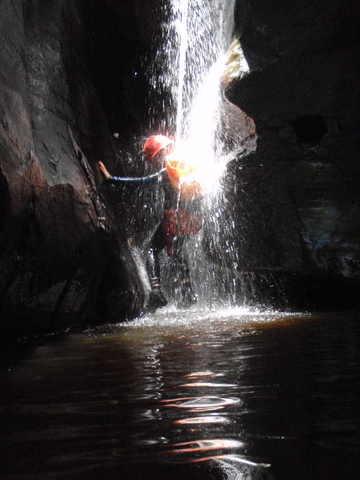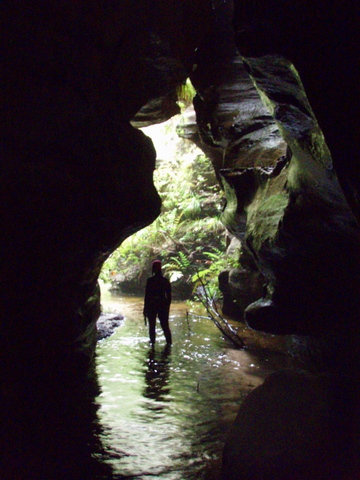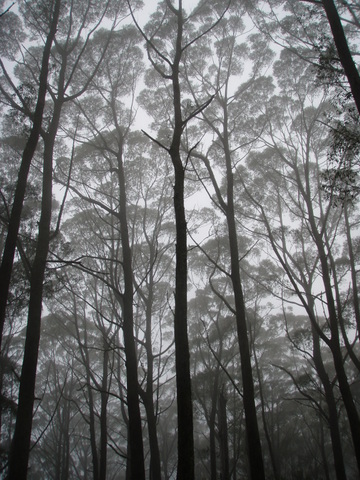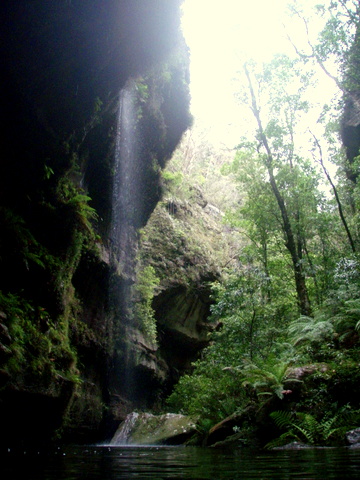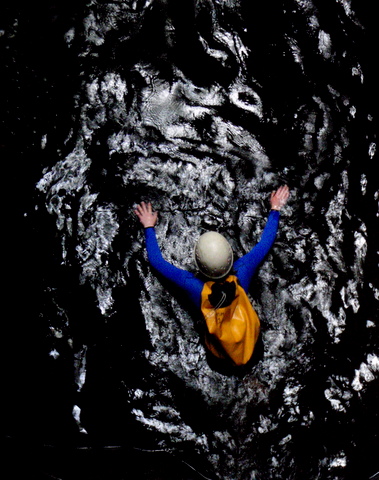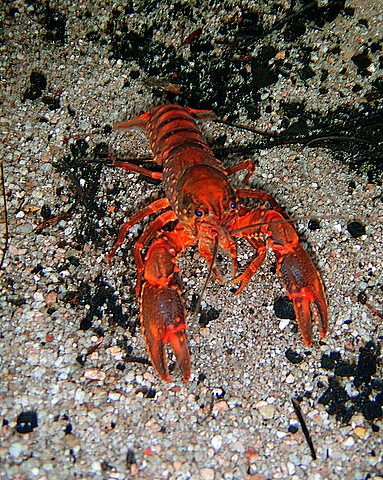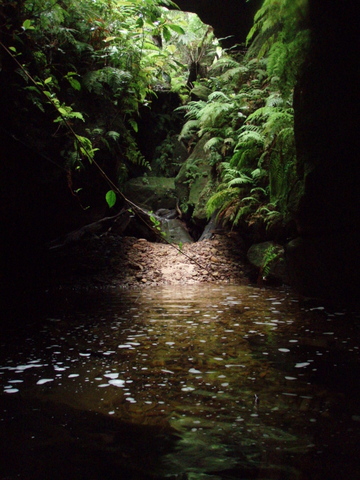- Details
Canyoning is a really exciting and pleasurable experience but some basic safety precautions need kept in mind. While exploring the canyons around Mt Wilson & Mt Irvine you will see native animals, wonderful geology, spectacular scenery and you will have the chance to descend into the narrow gorges which have been carved out by water over thousands of years.
Canyoning can also be very dangerous. It is easy to get into trouble. Members of the local RFS often assist Police and Ambulance with rescues, some with fatal consequences. We are there to help but would much prefer that you are fully aware of the dangers and take the necessary precautions. Let’s not meet by accident.
Important Safety Information and Precautions (please ensure you read):
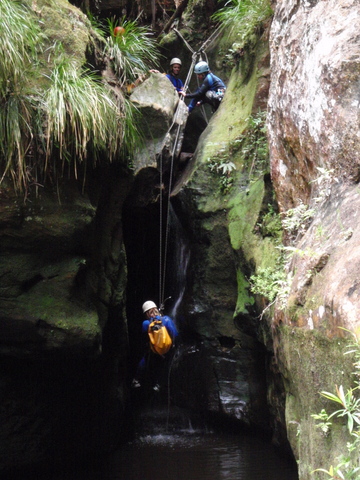
- If you are a beginner, go with a bushwalking club or a commercial adventure company.
- Always let someone know where you are going and leave a plan of your route.
- Let people know your expected time of return.
- Always go with a small group and you need to ensure that all members are capable and know what the day entails.
- Please carry as a minimum: plenty of drinking water, matches, topographic map(s), a compass, warm dry clothing, a head torch, a space blanket, a first aid kit, raincoats for everyone in the group, vertical rescue equipment and an emergency shelter. Be prepared to spend a night in the canyon, maybe with an injured party member.
- Carry a Personal Location Beacon to give location if injured or lost (please only set off if genuine injury or life at risk). Mobile phone coverage in the area is poor and non existent in the canyons. Normally the best place to make phone calls from is along The Avenue between Queens Avenue, as you enter the Mt Wilson village, and the fire station. So you will not be able to rely on a mobile phone in an emergency. A Personal Location Beacon is the best bet in an emergency.
- Practise the canyon code of ethics which can be found here.
Canyoning
Canyoning (known as canyoneering in some parts of the world) is a magnificent activity that involves descending narrow gorges that have been carved by water over millions of years. Participants make their way through these canyons using a variety of techniques including abseiling (rappelling), scrambling, swimming, jumping and walking (amongst much else!). Canyoning is most popular during the summer months but some trips are done all year round. A canyoning trip can be as short as a few hours, or last as long as a few days.
The areas surrounding the townships of Mt Wilson and Mt Irvine include some of the most popular canyon adventures in Australia and have some of the most spectacular canyons to be found anywhere in the world.
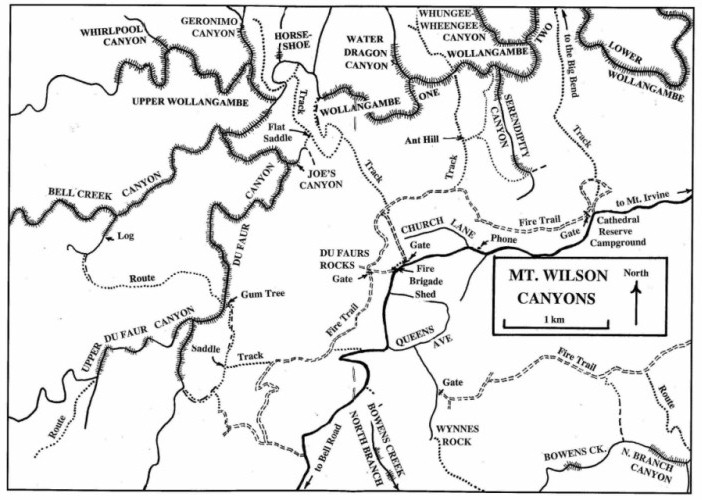
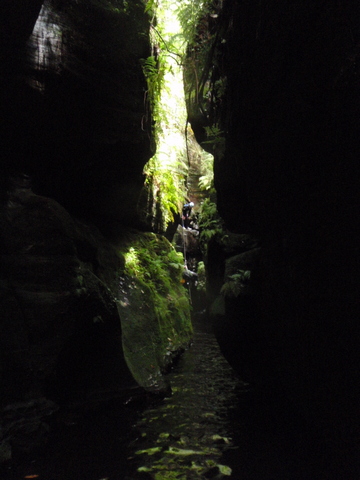 Popular Canyons in the Mt Wilson and Mt Irvine Area
Popular Canyons in the Mt Wilson and Mt Irvine Area
There are many canyons in the Mt Wilson and Mt Irvine area and literally hundreds more in the National Park nearby, here a is a very small sample of some of the canyons in the area.
Joe's Canyon
Joe's Canyon is a lovely short introductory canyon that is appropriate for the whole family. It is medium grade walk, just one hour from the Mt Wilson Fire Brigade Shed on Mt Wilson Road. There are no abseils and if you are careful you only get wet up to your knees. A li-lo or tyre tube is needed for each person.
Joe Canyon Video - Shoes on my Feet
The Wollangambe River (Wollangambe One)
The Wollangambe is the river that flows roughly west to east just to the north of the townships of Mt Wilson and Mt Irvine. A popular day trip involves walking down to the river and then floating, walking, scrambling, and generally splashing your way between the grand cliffs towering above the water before making the hard slog back uphill to the car. Often described as an introductory trip, it is actually a fairly long and physically demanding day out. A wet suit or good woollen jumper and li-lo or tyre tube is needed for each person.
Serendipity
Serendipity (also known as “Why Don't We Do It In The Road”) is an intermediate level trip that has a number of abseils to negotiate, as well as cold, dark swims in narrow constrictions in the canyon. It ends with an exploration of part of the Wollangambe River.
Serendipity Canyon Video - Shoes on my Feet
Secret Gobsmacker
“Secret Gobsmacker” canyon (which is the Lower Section of the North Branch of Bowens Creek) is on the southern side of the village of Mt Wilson. To get to the canyon you descend through a beautiful temperate rainforest. Once in the canyon itself there are some stunning fern and moss lined walls, several fun abseils and lots of wildlife like Yabbies, Water Dragons, and Mountain Galaxia. The walk out involves short scrambling sections and some great views.
Gobsmacker Canyon and Helicopeter Rescue Video - Shoes on my Feet
Whungee Wheengee
One of the finest canyons anywhere. Whungee Wheengee is a maze of caverns, boulder jams, and short abseils. Suitably only for the very fit and experienced Whungee Wheengee is a long, hard and very rewarding day. Li-los or some flotation device are needed for each person for the Wollangambe Creek exit. A wet suit is recommended.
DISCLAIMER
Canyoning is a dangerous activity. This information is provided as general information only. Expert advice and information should be sought before attempting any of these activities yourself.
How do I go canyoning?
Canyoning requires a broad range of skills including navigation, abseiling and vertical rescue, first aid, and general bushcraft.
Bushwalking Clubs
Many bushwalking clubs around Sydney and the Blue Mountains run canyoning activities as part of their trip offerings. They usually have some membership and training requirements before you can join on certain trips but can be an excellent way to see many locations over a period of time. The Federation of Bushwalking Clubs is the best place to go to find information about a club in your area, but there are also a handful of online communities that occassionally allow beginners to join organised expeditions.
Commercial Groups
There are a number of commercial adventure companies that operate in the Blue Mountains. They provide fully guided tours for people of experience levels: from absolute beginners through to very experienced people. They generally provide all the equipment required for the activity and group sizes are limited to 8-10 people as a maximum.
Wollemi Wanders is a local boutique adventure company running guided canyoning trips and bushwalks for small groups, with all equipment and meals provided. In addition to the offerings on their website, which vary seasonally, they are open to requests for specific canyons or walking routes, and also offer private trips which include transport from your accommodation in the Blue Mountains area.
Canyon Training
If you are interested in learning to canyon yourself, then there are a few places you can go to learn the skills required. The Bushwalking Clubs sometimes run training courses in navigation, first aid, self rescue on ropes, and other basic canyoning techniques. Some of the commercial canyoning companies also run short courses that teach these skills. If you would like the most comprehensive training available then there a few Registered Training Organisation's (like the Blue Mountains TAFE college) that run more comprehensive courses on how to be a canyon guide.
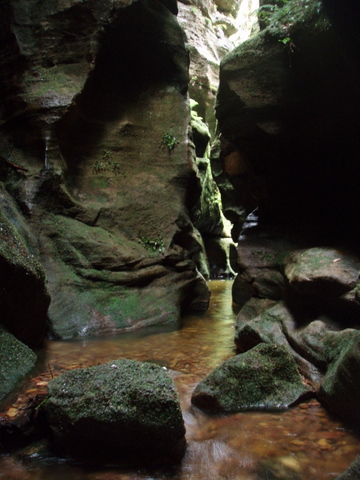 Guide Books
Guide Books
If you already have the skills to go canyoning yourself but are looking for where to go in the Blue Mountains, there are many resources available online and a quick serach will pull up the more popular sites. Along with the information available through various websites there is one printed guidebook that is available called “Canyons Near Sydney” by Rick Jamieson. Care must be taken with all guidebooks as they contain much that is personal opinion, and conditions in the canyons may have changed since they were last reviewed. The descriptions are also sometimes deliberately brief.
What else do I need to know?
Canyon Code of Ethics and looking after the environment
Always check with the National Parks and Wildlife Services for park closures and safety updates and NPWS Canyon Code of Ethics.
Group Sizes
The ideal canyoning group size is 4-6 people. If there is an accident in the group it is a good idea to be able to leave one person to help with the injured member of the party while some others can go and seek assistance. Large groups often have a negative impact on the environment by trampling sensative vegetation, and can move very slowly through trickier sections of the canyon (for example when there are multiple consecutive abseils). The NSW National Parks and Wildlife Service also have guidelines for maximum canyoning group sizes.
Canyoning Equipment
Equipment can be purchased from many retailers throughout Australia. Equipment required varies depending on the particular canyon adventure you choose, but may include ropes (various lengths, diameters and types are available), a harness, helmet, wetsuit, descender (a figure 8, tubular device, “rap rack”, or many others), ascenders (prussiks or mechanical devices), backpack, drybag, floatation device (lilo, inflatable airbed, PFD/lifejacket or other), anchoring equipment (camming devices, passive jamming devices, bolt plates, slings and much else), whistle, emergency shelter, comprehensive first aid kit, fire starting equipment, fuel stove, billy, torch (and spare!), wetsuit, good footwear (shoes that can get wet and thick warm socks), food, spare warm clothing, a map and compass, emergency communications device (PLB/EPIRB or other) and much more! Talk to an experienced canyoner about what equipment they would recommend.
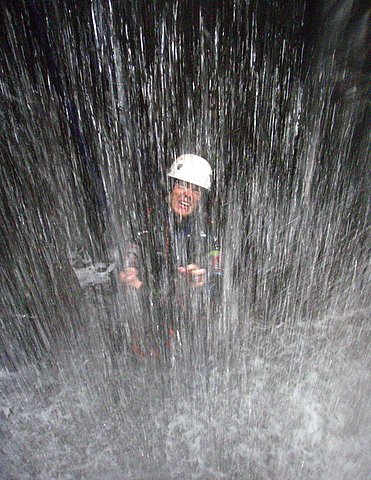 Trip Intentions Form
Trip Intentions Form
You should always let someone know where you are going whenever you go out in the bush in the Mt Wilson and Mt Irvine area. If you plan on doing an extended bushwalk or canyon it is worth leaving a more detailed plan of your trip with a trusted friend.
A trip intentions form is a great way of doing this and should have as a minimum the following information:
- Location(s) where vehicle(s) will be parked and vehicle(s) make, model and registration
- Location where walk will start (including name of map and grid reference)
- Time and date when walk will start
- A description of the planned route
- Location where walk will finish (including name of map and grid reference)
- Time and date when walk is intended to finish
- Names, phone numbers and emergency contact details for each member in the group
- A list of the critical equipment that the group will be carrying (for example maps,compass, first aid kit, food, water, warm clothing, tents/shelter, sleeping bags, fire starters, fuel stoves, whistles, ropes, communications devices, emergency beacons, any other)
- And finally, instructions of what to do if you do not return as intended. For example: “If the group has not returned or contacted you by (time) on (day/date) then please contact (person) on (number) and give them these details”.
Phone Reception, Communications and other Electronic Devices
There is generally no phone reception in canyons. Further, phone reception on the majority of bushwalks in the Mt Wilson area could be best described as patchy, poor or non-existent. Due to the cliff environment, Satellite phones, UHF and most other radio or communication devices perform poorly in canyons too. GPS navigation systems also only work intermittently in canyons and so should not be relied upon, all parties should have someone in the group who is carrying and knows how to use a map and compass.
The Blue Mountains Police in conjunction with the NSW National Parks and Wildlife Service provide free Personal Locator Beacon (PLB) hire through their Think Before you Trek initiative. To find out more go to the Think Before you Trek website.
Rescues
For all emergencies use a personal locator beacon or call 000 (triple zero), but please remember you will probably have no phone coverage unless one of you walks back to the Mt Wilson Fire Station.
